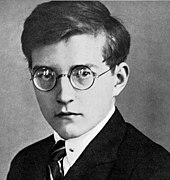Dmitri Shostakovich stands as a towering figure in 20th-century classical music, his life and works inextricably linked to the tumultuous history of the Soviet Union. Born in 1906 in St. Petersburg, Russia, Shostakovich’s journey through the world of music was marked by incredible triumphs and harrowing challenges. This comprehensive biography delves into the life, contributions, and enduring legacy of one of the most influential composers of his time.
Early Life and Musical Beginnings
Dmitri Dmitriyevich Shostakovich was born into a middle-class family with a strong appreciation for music. His mother, a pianist, recognized his musical talent early on and began teaching him piano at the age of nine. Young Dmitri’s prodigious abilities quickly became apparent, and he entered the Petrograd Conservatory at just 13 years old.
During his time at the conservatory, Shostakovich studied under Alexander Glazunov, the institution’s director and a renowned composer in his own right. It was here that Shostakovich began to develop his unique compositional voice, blending traditional forms with innovative harmonies and rhythms.
Rise to Fame: First Symphony and Early Success
Shostakovich’s graduation piece, the First Symphony, premiered in 1926 when he was just 19 years old. The work was an immediate success, catapulting the young composer to national and international fame. This early triumph set the stage for a prolific career that would span nearly five decades.
The success of his First Symphony opened doors for Shostakovich, leading to commissions for film scores, ballets, and more symphonic works. His opera “The Nose” (1928), based on Nikolai Gogol’s surrealist short story, further cemented his reputation as an innovative and daring composer.
Navigating Soviet Politics: The Lady Macbeth Controversy
In 1934, Shostakovich premiered his opera “Lady Macbeth of the Mtsensk District.” Initially hailed as a masterpiece, the opera’s fortunes changed dramatically in 1936 when Joseph Stalin attended a performance. Shortly after, an infamous article appeared in Pravda, the official Communist Party newspaper, denouncing the opera as “muddle instead of music.”
This event marked the beginning of a difficult period for Shostakovich. Many of his friends and family members were arrested or executed during the Great Purge, and the composer himself lived in constant fear of arrest. He withdrew his Fourth Symphony before its premiere, fearing it would be too controversial.
Redemption and Wartime Compositions
Shostakovich’s Fifth Symphony, premiered in 1937, was presented as a response to “just criticism.” The work was a critical and popular success, striking a delicate balance between artistic integrity and political necessity. This symphony, with its outwardly triumphant finale masking deeper layers of tragedy and irony, exemplified Shostakovich’s ability to speak to audiences on multiple levels.
During World War II, Shostakovich remained in Leningrad (now St. Petersburg) during the Nazi siege. His Seventh Symphony, known as the “Leningrad Symphony,” became a powerful symbol of resistance and was performed in the besieged city in 1942. This work solidified Shostakovich’s international reputation and became a potent propaganda tool for the Soviet war effort.
Post-War Years: Renewed Pressures and Private Expressions
The post-war years brought renewed political pressure on Soviet artists. In 1948, Shostakovich, along with other prominent composers, was denounced for “formalist tendencies” in their music. This led to a period where Shostakovich outwardly conformed to official demands while privately composing more personal pieces.
Works from this period include the autobiographical Eighth String Quartet (1960) and the deeply moving Thirteenth Symphony “Babi Yar” (1962), based on poems by Yevgeny Yevtushenko that addressed Soviet anti-Semitism.
Later Years and Legacy
In his later years, despite declining health, Shostakovich continued to compose prolifically. Works like the haunting Fourteenth Symphony (1969) and the introspective Fifteenth Symphony (1971) showcase a composer grappling with mortality and reflecting on a life lived under constant scrutiny.
Shostakovich passed away in 1975, leaving behind a complex and enduring legacy. His influence extended beyond his compositions to his teaching and mentorship of younger composers at the Leningrad and Moscow Conservatories.
Famous Works of Dmitri Shostakovich
Shostakovich’s oeuvre is vast and varied, encompassing numerous genres. Some of his most famous works include:
- Symphonies: Particularly the Fifth, Seventh (“Leningrad”), and Tenth Symphonies
- String Quartets: Especially the Eighth String Quartet
- Operas: “Lady Macbeth of the Mtsensk District”
- Concertos: Piano Concerto No. 2, Violin Concerto No. 1
- Chamber Music: Piano Quintet in G minor
- Film Scores: “The New Babylon,” “Hamlet”
Shostakovich’s Musical Style and Influence
Shostakovich’s musical style is characterized by its emotional intensity, sardonic wit, and innovative use of traditional forms. He often employed dissonance and unconventional harmonies to create tension and express complex emotions. His ability to infuse classical forms with modern sensibilities made his music accessible yet profoundly moving.
The influence of Shostakovich on subsequent generations of composers is immeasurable. His works continue to be performed and studied worldwide, with musicians and scholars still uncovering new layers of meaning in his compositions.
Conclusion: A Legacy of Resilience and Artistry
Dmitri Shostakovich’s life and work embody the struggles of artists under totalitarian regimes. His ability to create profound, emotionally resonant music while navigating the dangerous waters of Soviet cultural politics is a testament to his genius and resilience. Today, he is remembered not just as a great composer, but as a symbol of the enduring power of art in the face of oppression.

